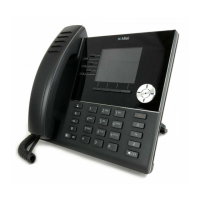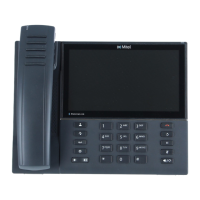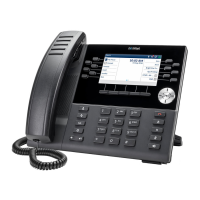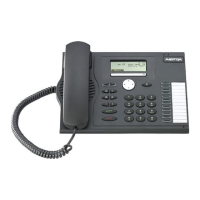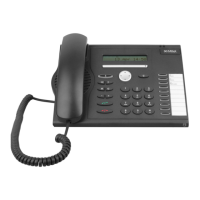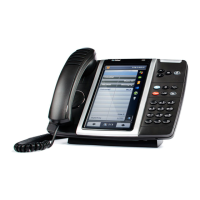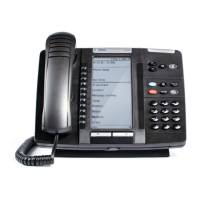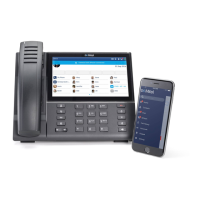Do you have a question about the Mitel MiVOICE 6930 and is the answer not in the manual?
Explains the purpose and scope of the user guide.
Information on how to access additional phone and system documentation.
Guidance on basic phone installation and physical setup.
Advice on ergonomics and protecting user hearing.
Description of the physical layout of phone keys.
Detailed explanation of each key's function and label.
Information on using the numerical dialpad for dialing and text input.
Introduction to the phone's User Interface elements and screens.
Details about the default screen displayed when the phone is idle.
Explanation of icons indicating phone and network status.
Explanation of interactive keys and their functionalities.
Steps to access and navigate the phone's settings menu.
View network and phone information via the settings menu.
Allows selection of the desired language for on-screen text.
Configuration of call forwarding rules for incoming calls.
Settings for enabling and managing Bluetooth device connectivity.
Personalization of ring tones and audio path settings.
Configuration for enabling DHSG mode with compatible headsets.
Settings for adjusting screen brightness and screen saver.
Configuration for remote worker mode via IP address.
Tools for performing diagnostic routines on the phone.
Captures audio log files to help debug audio issues.
Verifies network connections by pinging a host name or IP address.
Captures TCP network packets for debugging and troubleshooting.
Performs DHCP trace requests and reviews returned parameters.
Settings for connecting the phone to a wireless network.
Steps to connect the phone to a wireless network.
Allows restarting the phone when experiencing unexpected behavior.
Explains the status indication provided by LEDs on programmable keys.
How to program and use speed dial keys for quick dialing.
Programmable features like Phone Lock, Call Forward, DND, etc.
How to program and use the phone lock feature for security.
Programming and enabling the Call Forward Always feature.
Programming and enabling the Do Not Disturb feature.
Using the Mobile Line feature for mobile phone integration.
How to use account codes for call accounting and reporting.
Using float keys to display and manage incoming lines.
Procedures for dialing numbers using handset, speaker, or headset.
Redialing the most recently dialed number.
How to request notification when a busy line becomes free.
Steps to answer an incoming call using various audio paths.
Forwarding an incoming call to a defined number manually.
Procedure for placing an active call on hold.
How to mute and unmute the microphone during a call.
Performing unattended and attended call transfers.
Steps to set up conference calls with multiple participants.
Procedures for ending active calls or conference calls.
Personal phone book and directory management.
Accessing and navigating the Contacts application.
How to search for contacts in personal, mobile, or corporate folders.
Making calls directly from the Contacts application.
Adding, editing, and deleting contacts in the personal folder.
Managing contacts from corporate and mobile directories.
Stored log of all outgoing, received, and missed calls.
Copying call history entries to the phone's personal contacts.
How the missed calls icon indicates unanswered calls.
Accessing and managing voicemail messages.
Interacting visually with voicemail messages and counts.
Steps to log in to the voicemail service.
Procedures for playing voicemail messages.
How to delete voicemail messages.
Sending a voicemail message to a specified phone number.
Adding voicemail numbers to the phone's contacts.
Manually synchronizing mobile phone contacts with the phone.
How mobile call history is synced and displayed.
How to view the call history of a paired mobile phone.
How to view missed calls from the mobile phone.
Manually updating the mobile call history and missed calls.
Making calls from the mobile phone's call history.
Adding mobile call history entries to the phone's contacts.
Answering mobile calls on the IP phone.
Deleting mobile call history and missed calls from the phone.
Switching audio between the mobile phone and IP phone.
Account Codes, ACD, Auto Answer, Call Forwarding options.
Call Park, Call Pickup, CDE Speedcall, Direct Page.
Do Not Disturb, DSS/Busy Lamp, Emergency Call Notification, Float Keys.
Group Listen, Group Park, Group Presence, Handoff.
Key System, Make Busy, Meet Me Answer, Message Waiting Indication.
Night Answer, Night Service Indication, Paging.
Personal Presence, Phone Lock, Privacy Release.
Record a Call, Secretarial, Specific Group Alert, Superkey, Tag Call.
User Speedcall and User Speedcall - Private.
Adding wireless connectivity to the IP phone.
Details about the programmable key module and its features.
Features and specifications of the integrated DECT headset.
Instructions on charging and upgrading the headset firmware.
How to check the headset's battery and firmware status.
Description of LED indicators for headset status and battery.
Procedure for replacing a malfunctioning or incorrectly paired headset.
Overview and features of the Bluetooth speakerphone accessory.
Description of the speakerphone's physical buttons and indicators.
Features of the cordless Bluetooth handset.
Description of the cordless handset's hardware buttons and LEDs.
Explanation of LED colors and states for handset status and battery.
Description of alerting tones for handset events.
Information on connecting and using various types of headsets.
Limitations and conditions not covered by the warranty.
Information on obtaining warranty repair services.
Information on repair and support options after the warranty period.
Explains the purpose and scope of the user guide.
Information on how to access additional phone and system documentation.
Guidance on basic phone installation and physical setup.
Advice on ergonomics and protecting user hearing.
Description of the physical layout of phone keys.
Detailed explanation of each key's function and label.
Information on using the numerical dialpad for dialing and text input.
Introduction to the phone's User Interface elements and screens.
Details about the default screen displayed when the phone is idle.
Explanation of icons indicating phone and network status.
Explanation of interactive keys and their functionalities.
Steps to access and navigate the phone's settings menu.
View network and phone information via the settings menu.
Allows selection of the desired language for on-screen text.
Configuration of call forwarding rules for incoming calls.
Settings for enabling and managing Bluetooth device connectivity.
Personalization of ring tones and audio path settings.
Configuration for enabling DHSG mode with compatible headsets.
Settings for adjusting screen brightness and screen saver.
Configuration for remote worker mode via IP address.
Tools for performing diagnostic routines on the phone.
Captures audio log files to help debug audio issues.
Verifies network connections by pinging a host name or IP address.
Captures TCP network packets for debugging and troubleshooting.
Performs DHCP trace requests and reviews returned parameters.
Settings for connecting the phone to a wireless network.
Steps to connect the phone to a wireless network.
Allows restarting the phone when experiencing unexpected behavior.
Explains the status indication provided by LEDs on programmable keys.
How to program and use speed dial keys for quick dialing.
Programmable features like Phone Lock, Call Forward, DND, etc.
How to program and use the phone lock feature for security.
Programming and enabling the Call Forward Always feature.
Programming and enabling the Do Not Disturb feature.
Using the Mobile Line feature for mobile phone integration.
How to use account codes for call accounting and reporting.
Using float keys to display and manage incoming lines.
Procedures for dialing numbers using handset, speaker, or headset.
Redialing the most recently dialed number.
How to request notification when a busy line becomes free.
Steps to answer an incoming call using various audio paths.
Forwarding an incoming call to a defined number manually.
Procedure for placing an active call on hold.
How to mute and unmute the microphone during a call.
Performing unattended and attended call transfers.
Steps to set up conference calls with multiple participants.
Procedures for ending active calls or conference calls.
Personal phone book and directory management.
Accessing and navigating the Contacts application.
How to search for contacts in personal, mobile, or corporate folders.
Making calls directly from the Contacts application.
Adding, editing, and deleting contacts in the personal folder.
Managing contacts from corporate and mobile directories.
Stored log of all outgoing, received, and missed calls.
Copying call history entries to the phone's personal contacts.
How the missed calls icon indicates unanswered calls.
Accessing and managing voicemail messages.
Interacting visually with voicemail messages and counts.
Steps to log in to the voicemail service.
Procedures for playing voicemail messages.
How to delete voicemail messages.
Sending a voicemail message to a specified phone number.
Adding voicemail numbers to the phone's contacts.
Manually synchronizing mobile phone contacts with the phone.
How mobile call history is synced and displayed.
How to view the call history of a paired mobile phone.
How to view missed calls from the mobile phone.
Manually updating the mobile call history and missed calls.
Making calls from the mobile phone's call history.
Adding mobile call history entries to the phone's contacts.
Answering mobile calls on the IP phone.
Deleting mobile call history and missed calls from the phone.
Switching audio between the mobile phone and IP phone.
Account Codes, ACD, Auto Answer, Call Forwarding options.
Call Park, Call Pickup, CDE Speedcall, Direct Page.
Do Not Disturb, DSS/Busy Lamp, Emergency Call Notification, Float Keys.
Group Listen, Group Park, Group Presence, Handoff.
Key System, Make Busy, Meet Me Answer, Message Waiting Indication.
Night Answer, Night Service Indication, Paging.
Personal Presence, Phone Lock, Privacy Release.
Record a Call, Secretarial, Specific Group Alert, Superkey, Tag Call.
User Speedcall and User Speedcall - Private.
Adding wireless connectivity to the IP phone.
Details about the programmable key module and its features.
Features and specifications of the integrated DECT headset.
Instructions on charging and upgrading the headset firmware.
How to check the headset's battery and firmware status.
Description of LED indicators for headset status and battery.
Procedure for replacing a malfunctioning or incorrectly paired headset.
Overview and features of the Bluetooth speakerphone accessory.
Description of the speakerphone's physical buttons and indicators.
Features of the cordless Bluetooth handset.
Description of the cordless handset's hardware buttons and LEDs.
Explanation of LED colors and states for handset status and battery.
Description of alerting tones for handset events.
Information on connecting and using various types of headsets.
Limitations and conditions not covered by the warranty.
Information on obtaining warranty repair services.
Information on repair and support options after the warranty period.
| DECT connectable | Yes |
|---|---|
| Maximum indoor range | 10 m |
| Touchscreen | - |
| Display diagonal | 4.3 \ |
| Display resolution | 480 x 272 pixels |
| Wi-Fi standards | 802.11a, 802.11b, 802.11g |
| Bluetooth version | 4.1 |
| Security algorithms | 64-bit WEP, 802.1x RADIUS, EAP-FAST, EAP-PEAP, EAP-TLS, EAP-TTLS, WPA-AES, WPA-PSK, WPA-TKIP, WPA2-AES, WPA2-PSK, WPA2-TKIP |
| Networking standards | IEEE 802.11a, IEEE 802.11b, IEEE 802.11g, IEEE 802.11n, IEEE 802.3, IEEE 802.3ab, IEEE 802.3af, IEEE 802.3at, IEEE 802.3u |
| Ethernet LAN data rates | 10, 100, 1000 Mbit/s |
| Ethernet LAN interface type | Gigabit Ethernet |
| Lines quantity | - lines |
| Phonebook capacity | - entries |
| USB 2.0 ports quantity | 1 |
| Ethernet LAN (RJ-45) ports | 2 |
| Standby time | 40 h |
| Number of handles included | 1 pc(s) |
| Number of programmable keys | 12 |
| Front camera | No |
| Handset type | Wireless handset |
| Product type | IP Phone |
| Product color | Black |
| Harmonized System (HS) code | 85171800 |

